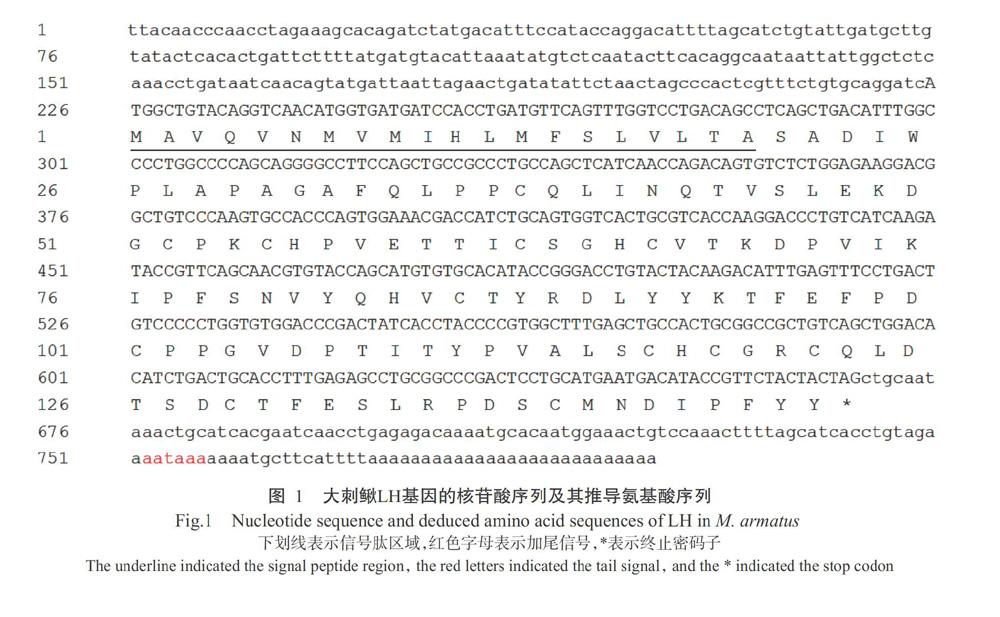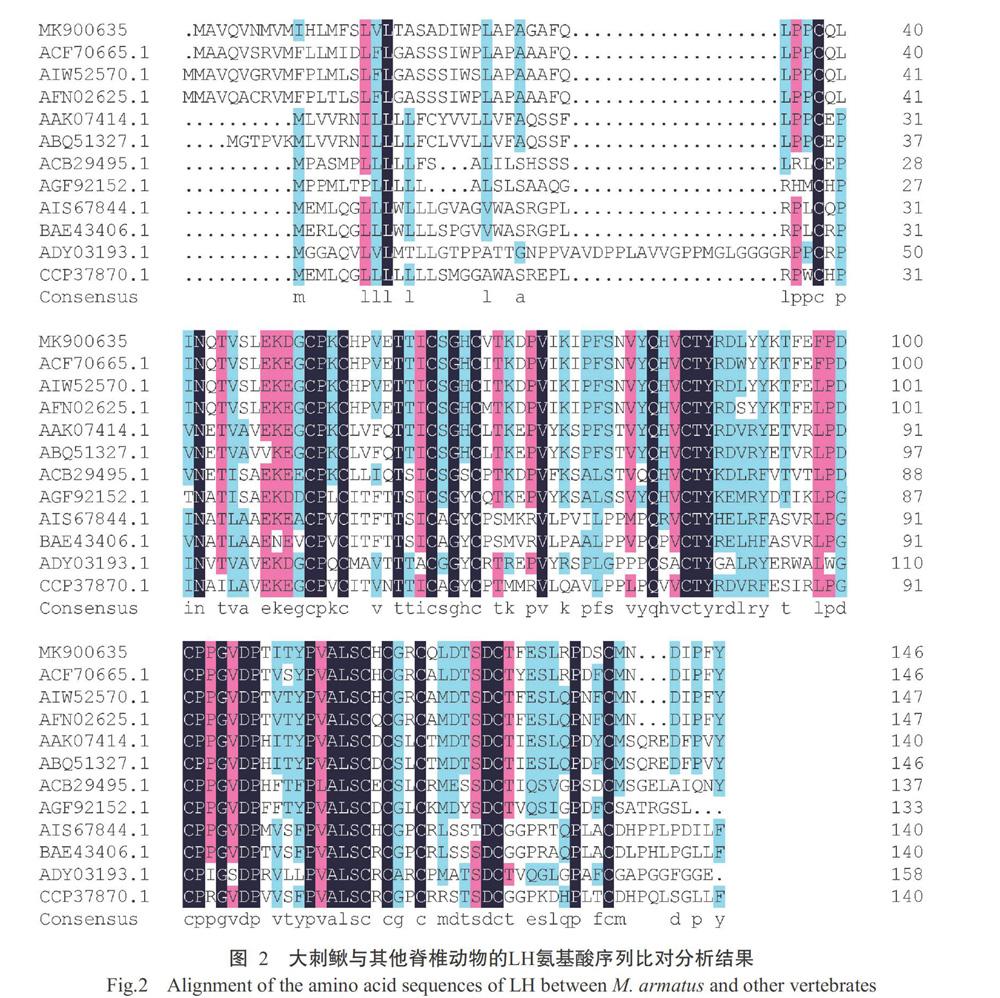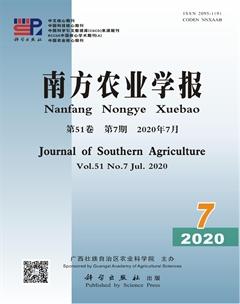大刺鳅促黄体生成素基因克隆及其组织表达分析
黄小琪 钟东明 何佩莹 张明清 周惠强 舒琥



摘要:【目的】克隆大刺鰍(Mastacembelus armatus)促黄体生成素(LH)基因及明确其表达规律,为进一步阐明LH基因在大刺鳅性腺发育过程中的生理功能及揭示大刺鳅的生殖调控机理提供参考依据。【方法】采用RACE克隆大刺鳅LH基因cDNA全长序列,从GenBank中选择硬骨鱼类、两栖动物、鸟类和哺乳动物等物种的LH氨基酸序列,通过ClustalX 2.1进行氨基酸序列比对,以MEGA 6.0中的邻接法(NJ)构建系统发育进化树,并应用实时荧光定量PCR检测分析大刺鳅LH基因在不同组织及不同性腺发育期的表达情况。【结果】大刺鳅LH基因cDNA序列全长799 bp,包括224 bp的5'非编码区(5'-UTR)、131 bp的3'非编码区(3'-UTR)和444 bp的开放阅读框(ORF),共编码147个氨基酸残基,第1~22位氨基酸残基组成其信号肽区域。大刺鳅LH氨基酸序列C-末端区域高度保守,但N-末端区域与其他硬骨鱼类、两栖动物、鸟类和哺乳动物存在明显差异。大刺鳅LH氨基酸序列与其他鱼类的LH氨基酸序列同源性较高,其中与黄鳝(Monopterus albus)的亲缘关系最近。大刺鳅LH基因在其脑组织中的相对表达量最高,显著高于在其他组织中的相对表达量(P<0.05);在卵巢、心脏、肝脏和精巢中的相对表达量次之;大刺鳅LH基因在不同发育期卵巢和精巢中的表达变化趋势一致,从II期开始其相对表达量随之增加,至V期时达峰值。【结论】大刺鳅LH氨基酸序列具有高度保守区域,其基因在各组织中广泛表达,尤其在脑组织和性腺中具有较高表达量,提示LH的靶基因可能在脑—垂体—性腺轴上,参与大刺鳅的性腺发育调控,主要促进卵母细胞和精子成熟并刺激排卵或排精。
关键词: 大刺鳅;促黄体生成素(LH);性腺发育;基因克隆;组织表达
中图分类号: S965.199 文献标志码: A 文章编号:2095-1191(2020)07-1706-08
Abstract:【Objective】To clone luteinizing hormone(LH) gene from Mastacembelus armatus and clarify its expre-ssion rules, which could provide the reference for further elucidating the physiological functions of LH gene in the development of gonads and revealing the mechanism of reproductive regulation. 【Method】In this experiment, the full-length cDNA of M. armatus was cloned through the RACE techniques. The LH amino acid sequence of bony fish, amphibians, birds and mammals from GenBank were chosen while the amino acid sequence alignment was performed by ClustalX 2.1. Using the method of neighbour-joining(NJ) of MEGA 6.0 to construct the phylogenetic trees and the expression of LH gene in various tissues and at different gonads development stages were detected through qRT-PCR techniques. 【Result】The full length cDNAsequence of LH gene was 799 bp, including a 5' non-coding region(5'-UTR) of 224 bp, a 3'-UTR of 131 bp, and an open reading frame(ORF) of 444 bp. A total of 147 amino acid residues were encoded, and amino acid residues at positions 1-22 formed the signal peptide region. The C-terminal region of LH amino acid sequence of M. armatus was highly conserved, but the N-terminal region was different from that of other bony fish, amphibians, birds and mammals. The amino acid sequence of LH of M. armatus was highly homologous with that of other fishes, among which the closest relative was Monopterus albus. The relative expression level of LH gene of M. armatus was the highest in its brain tissue, which was significantly higher than that in other tissues(P<0.05). The relative expression in ovary, heart, liver and testis were followed behind brain. The expression of LH gene in ovary and testis of M. armatus showed the same trend at different developmental stages, and its relative expression increased from stage II to the peak at stage V. 【Conclusion】The LH amino acid sequences of the M. armatus have highly conserved regions and are widely expressed in various tissues, especially in the brain and gonads, which suggests that the target gene of LH might be on the brain-pituitary-gonadal axis and participate in the regulation of gonadal development of M. armatus. It mainly promotes oocyte and sperm maturation and stimulates ovulation and ejaculation.
Key words: Mastacembelus armatus; luteinizing hormone(LH); gonadal development; gene cloning; tissue expression
Foundation item: China-ASEAN Maritime Cooperation Foundation(Waicaihan〔2017〕513);Guangdong Marine Fishery Science and Technology Research and Development Project(A201601A05);Guangdong Marine and Fishery Development Special Project(2017A0007)
0 引言
【研究意义】大刺鳅(Mastacembelus armatus)隶属于合鳃目(Synbranchiformes)刺鰍科(Mastacembelidae)刺鳅属(Mastacembelus),广泛分布在东南亚地区及我国长江以南的各大水系,其肉质鲜美,营养丰富,深受消费者青睐,是一种重要的淡水经济鱼类(赵子明和刘美剑,2017;周惠强,2019)。近年来,由于过度捕捞及生态环境恶化,我国大刺鳅野生资源急剧减少,福建、广东、湖南等省已将其列为重点保护野生水生动物(杨华强等,2016;舒琥等,2017)。因此,加强大刺鳅生殖调控机理研究,对其种质资源的保护和利用具有重要意义。【前人研究进展】至今,针对大刺鳅的研究主要集中在生物学特征(黄永春,1999;初庆柱等,2009)、人工繁殖技术(薛凌展,2016;曾庆祥等,2016)及遗传多样性分析(林婷婷,2017;江小璐,2018;舒琥等,2017;周惠强等,2019)等方面,有关其生殖调控相关基因的研究尚无报道。促黄体生成素(Luteinizing hormone,LH)是由脑垂体前叶细胞分泌,通过血液循环到达性腺及其他组织的一类糖蛋白激素(Hurvitz et al.,2005;曹洪涛,2010)。Prat等(1996)采用放射免疫法测定虹鳟鱼(Oncorhynchus mykiss)的促性腺激素(GTH),结果发现LH在性腺成熟时大量分泌并达峰值,其生物学功能是主要刺激7α,20β-二羟黄体酮生成,从而促使卵母细胞和精子成熟并刺激排卵和排精。也有研究证实,大马哈鱼(Oncorhynchus keta)存在2种不同类型的GTH,其表达形式及在不同发育时期的表达水平也存在明显差异,其中LH主要调控性腺成熟及排精/排卵(Schulz et al.,2001,2002;Swanson et al.,2003)。目前,已从条纹狼鲈(Morone saxatilis)(Ha-ssin et al.,1995)、金头鲷(Sparus aurata)(Elizur et al.,1996)、金鱼(Carassius auratus)(Yoshiura et al.,1997)、真鲷(Pagrosomus major)(Gen et al.,2000)、半滑舌鳎(Cynoglossus semilaevis Gunther)(柳学周等,2014)及抚仙金线鲃(Sinocyclocheilus tingi)(杨国坤等,2016)等几十种鱼类中成功克隆获得LH基因,为揭示鱼类性腺发育的分子机制奠定了基础。【本研究切入点】LH对鱼类的生殖调控具有重要作用,但在大刺鳅上的研究至今鲜见报道。【拟解决的关键问题】采用RT-PCR和cDNA末端快速扩增技术(RACE)克隆大刺鳅LH基因全长cDNA序列,并以实时荧光定量PCR检测分析大刺鳅LH基因在不同组织及不同性腺发育期的表达情况,为进一步阐明LH基因在大刺鳅性腺发育过程中的生理功能及揭示大刺鳅的生殖调控机理提供参考依据。
1 材料与方法
1. 1 试验材料
供试大刺鳅采自云南澜沧江,体长270±5 mm,体质量150±5 g。选取3尾成年健康大刺鳅,以MS-222(50 mg/L)麻醉后进行解剖,采集脑组织、性腺、心脏、肝脏、脾脏、肾脏、肠道、胃、鳃组织和眼睛等组织样品,置于RNA Keeper(R501-01,南京诺维赞生物科技有限公司)中,液氮速冻后-80 ℃保存备用。同时选择不同性腺繁殖周期的大刺鳅(体长200±5 mm,体质量100±5 g),用MS-222麻醉后解剖采集卵巢和精巢,置于RNA Keeper中,液氮速冻后-80 ℃保存备用。
1. 2 总RNA提取及cDNA合成
采用RNAprep pure动物组织试剂盒[DP431,天根生化科技(北京)有限公司]从大刺鳅不同组织中提取总RNA,用1.2%琼脂糖凝胶电泳检测RNA完整性,并以酶标仪(1807035,美国BioTek公司)检测其浓度和纯度。
1. 3 大刺鳅LH基因克隆及序列分析
通过同源克隆获得大刺鳅LH基因的中间部分序列,然后根据中间部分序列设计引物LHRC1、LHRC2、LHRC3、LHRC4和LHRC5(表1),采用Pri-meScript Ⅱ1st Strand cDNA Synthesis Kit试剂盒(634860,TaKaRa)反转录合成cDNA第一链,并以此为模板进行RACE扩增。扩增程序:94 ℃预变性3 min;94 ℃ 30 s,60 ℃ 30 s,72 ℃ 2 min,进行40个循环;72 ℃延伸10 min。PCR扩增产物采用1.0%琼脂糖凝胶电泳进行检测,目的片段采用DNA凝胶回收试剂盒[生工生物工程(上海)股份有限公司]进行纯化,然后连接至pMD19-T载体上,并转化大肠杆菌DH5α感受态细胞,接种至含氨苄青霉素的固体培养基上,37 ℃培养12~16 h,挑菌扩大培养后通过菌液PCR筛选阳性克隆,送至生工生物工程(上海)股份有限公司测序。
将获得的正向和反向序列在NCBI数据库中进行同源性比对,使用SeqMan Pro Version 7.1.0对中间片段序列、正向和反向序列进行剪切拼接(周惠强,2019),以获得大刺鳅LH基因全长cDNA序列。使用NCBI数据库中的BLAST对大刺鳅LH基因全长cDNA序列进行同源性比对,以DNAMAN 6.0推导其氨基酸序列;从GenBank中选择硬骨鱼类、两栖动物、鸟类和哺乳动物等物种的LH氨基酸序列(表2),应用ClustalX 2.1进行LH氨基酸序列比对,具体操作为:选择比对模型Multiple Alignment Mode(多序列比对),默认参数设置,选用Do Complete Alignment(进行完全比对),比对结果以BOXSHADE Server进行着色处理。采用Multiple Sequence Alignment by CLUSTALW进行物种同源性比对,并以MEGA 6.0中的邻接法(Neighbor-joining,NJ)构建系统发育进化树,选择模型为Poisson Correction(泊松修正),自引导检验(Bootstrap)设为1000。
1. 4 大刺鰍LH基因表达分析
采用实时荧光定量PCR对大刺鳅LH基因在不同组织及不同性腺发育期的表达情况进行检测分析。按照HiScript[?] II Q RT SuperMix for qPCR(R223-01,南京诺维赞生物科技有限公司)说明反转录合成cDNA。以β-actin基因为内参基因、LHQF1和LHQR1为扩增引物(表1),采用ChamQTM SYBR? q-PCR Master Mix(Q311-02,南京诺维赞生物科技有限公司)试剂盒在LightCycler 480荧光定量PCR仪上进行操作,所用样品设3个重复。使用2?ΔΔCt法换算目的基因的相对表达量(Livak and Schmittgen,2001),并以SPSS 19.0进行单因素方差分析(One-way ANOVA)和Duncans多重比较。
2 结果与分析
2. 1 大刺鳅LH基因全长cDNA序列及系统发育进化分析结果
大刺鳅LH基因cDNA序列全长799 bp(登录号MK900635),包括224 bp的5'非编码区(5'-UTR)、131 bp的3'非编码区(3'-UTR)和444 bp的开放阅读框(ORF),共编码147个氨基酸残基(图1)。利用SignalP 3.0 Server对大刺鳅LH基因的编码氨基酸序列进行信号肽预测,结果显示第1~22位氨基酸残基组成其信号肽区域。大刺鳅LH氨基酸序列与其他鱼类的同源性较高,其中,与黄鳝(M. albus)和赤点石斑鱼(E. akaara)的同源性高达87%,与青鱼(M. piceus)的同源性为56%;与两栖动物大蝾螈(A. davidia-nus)和鸟类红原鸡(G. gallus)的同源性分别为48%和39%;与哺乳动物山羊(C. hircus)、灰仓鼠(C. migratorius)及人类(H. sapiens)的同源性分别为34%、34%和35%。根据LH氨基酸序列比对分析结果可知,大刺鳅LH氨基酸序列C-末端区域高度保守,但N-末端区域与其他硬骨鱼类、两栖动物、鸟类和哺乳动物存在明显差异(图2)。基于LH氨基酸序列同源性构建的系统发育进化树(图3)也显示,大刺鳅与其他鱼类聚为一支,其中与黄鳝的亲缘关系最近;与鱼类、两栖动物、鸟类和哺乳动物的亲缘关系越来越远,与传统的形态学分类结果一致。
2. 2 大刺鳅LH基因的组织表达分布情况
实时荧光定量PCR检测结果(图4)显示,大刺鳅LH基因在其脑组织中的相对表达量最高,显著高于在其他组织中的相对表达量(P<0.05,下同);在卵巢、心脏、肝脏和精巢中的相对表达量次之,且在这4种组织中的相对表达量无显著差异(P>0.05,下同);大刺鳅LH基因在其他组织中的相对表达量较低。
2. 3 大刺鳅LH基因在性腺不同发育期的表达情况
在雌性大刺鳅中,随着卵巢的不断发育成熟,从II期开始LH基因的相对表达量随之增加,但仍处于较低水平;至IV期显著升高,V期的相对表达量达峰值,显著高于其他发育期;至VI期LH基因的相对表达量显著降低,与II期和III期的相对表达量无显著差异(图5)。在雄性大刺鳅中,随着精巢的不断发育成熟,从II期开始LH基因的相对表达量也随之增加,但仍处于较低水平;至IV期显著升高,V期的相对表达量最高,显著高于其他发育期;至VI期LH基因的相对表达量也显著降低,但仍高于II期和III期的相对表达量(图6)。可见,大刺鳅LH基因在卵巢和精巢的表达变化趋势一致。
3 讨论
本研究成功克隆获得大刺鳅LH基因全长cDNA序列,并对其推导氨基酸序列进行同源性比对分析,结果显示,大刺鳅LH氨基酸序列与合鳃目中的黄鳝、鲈形目中的赤点石斑鱼和花鲈的同源性较高,但与鲤形目中的青鱼和草鱼的同源性较低;基于LH氨基酸序列同源性构建的系统发育进化树也显示,大刺鳅与合鳃目中的黄鳝、鲈形目的赤点石斑鱼和花鲈等鱼类聚为一支,与传统的形态学分类结果一致。大刺鳅LH基因的ORF包含12个半胱氨酸(Cys)残基和1个N-糖基化位点(第42~44位氨基酸),与中华鲟(Cao et al.,2009)、南方鲶(Southern catfish)(Wu et al.,2009)、半滑舌鳎(柳学周等,2014)和抚仙金线鲃(杨国坤等,2016)的研究结果相似;与其他物种的LH氨基酸序列比对分析结果显示,大刺鳅LH氨基酸序列C-末端区域高度保守,说明大刺鳅LH与其他脊椎动物的LH具有相似功能。
运用荧光实时定量PCR检测LH基因在大刺鳅各组织中的表达情况,结果显示,大刺鳅LH基因在所有组织中均有所表达,与金头鲷(Wong and Zohar,2004)和斑马鱼(Danio rerio)(So et al.,2005)的研究结果相似。大刺鳅LH基因在其脑组织中的相对表达量最高,其次是在卵巢、心脏、肝脏和精巢中。在性腺和脑组织中高表达,暗示LH的靶基因可能在脑—垂体—性腺轴上,参与大刺鳅的性腺发育调控。本研究还对大刺鳅LH基因在不同发育期卵巢和精巢中的表达情况进行分析,结果发现大刺鳅的卵巢和精巢发育至II期时,LH基因的相对表达量还很低,随后的相对表达量逐渐稳步上升,直到IV~V期其相对表达量急剧增加,在V期时达峰值。这与虹鳟鱼(Natio et al.,1991;Prat et al.,1996;Gomez et al.,1999)和许氏平鲉(Sebastes schlegeli)(Kim et al.,2005)的研究结果一致,说明LH主要促进卵母细胞和精子成熟并刺激排精或排卵。半滑舌鳎LH基因在卵巢VI期的表达量显著低于其他发育期(柳学周等,2014),而大刺鳅LH基因的最低表达量出现在卵巢Ⅱ期。由此可见,LH基因在性腺中的表达模式具有种间差异性。
本研究通过RACE克隆得到大刺鳅LH基因全长cDNA序列,对其进行氨基酸序列比对分析,并通过荧光实时定量PCR检测大刺鳅LH基因在不同组织中的特异性表达及在性腺不同发育期的表达变化情况,为进一步阐明LH基因的生理功能打下了基础,同时为揭示大刺鳅性腺发育调控机理提供了理论依据。
4 结论
大刺鳅LH氨基酸序列具有高度保守区域,其基因在各组织中广泛表达,尤其在脑组织和性腺中具有较高表达量,提示LH的靶基因可能在脑—垂体—性腺轴上,参与大刺鳅的性腺发育调控,主要促进卵母细胞和精子成熟并刺激排卵或排精。
参考文献:
曹洪涛. 2010. 齐口裂腹鱼(Schizothorax prenanti)FSHβ亚基与LHβ亚基cDNA全序列克隆及生物信息学分析[D]. 雅安:四川农业大学. [Cao H T. 2010. Molecular cloning cDNAs and Bioinformation analysis of follicle-stimula-ting hormone(FSH)-β subunit and luteinizing hormone (LH)-β subunit of Schizothorax prenanti[D]. Ya?an:Sichuan Agricultural University.]
初庆柱,陈刚,张健东,潘传豪,周晖. 2009. 大刺鳅消化系统的组织学研究[J]. 淡水渔业,39(2):14-18. [Chu Q Z,Chen G,Zhang J D,Pan C H,Zhou H. 2009. Histological studies on digestive system of Mastacembelus armatus[J]. Freshwater Fisheries,39(2):14-18.]
黄永春. 1999. 汀江大刺鳅食性和繁殖生物学[J]. 水产学报,23(S):1-6. [Huang Y C. 1999. Feeding habit and reproductive biology of Mastacembelus armatus in Tingjiang river[J]. Journal of Fisheries of China,23(S):1-6.]
江小璐. 2018. 华南及邻近地区不同群体大刺鳅的遗传多样性及亲缘地理研究[D]. 广州:广州大学. [Jiang X L. 2018. Genetic diversity and phylogeography of different populations of Mastacembelus armatus in Southern China and its adjacent areas[D]. Guangzhou:Guangzhou University.]
林婷婷. 2017. 大刺鳅(Mastacembelus armatus)微卫星标记开发及野生群体遗传多样性分析[D]. 广州:广州大学. [Lin T T. 2017. Isolation of microsatellite markers and population genetic diversity analysis in Mastacembelus armatus[D]. Guangzhou:Guangzhou University.]
柳學周,史宝,王珊珊,徐永江,李晓晓. 2014. 半滑舌鳎促黄体激素基因克隆和表达分析及其血清浓度测定[J]. 中国工程科学,16(9):50-60. [Liu X Z,Shi B,Wang S S,Xu Y J,Li X X. 2014. Full length cDNA cloning and expre-ssion of luteinizing hormone(LH) and which serum concentration was measured in half smooth tongue sole Cynoglossus semilaevis Günther[J]. Engineering Sciences,16(9):50-60.]
舒琥,江小璐,杨华强,林婷婷,周惠强,张明清,查广才. 2017. 华南地区7个大刺鳅野生群体的形态差异分析[J]. 广州大学学报(自然科学版),16(3):8-14. [Shu H,Jiang X L,Yang H Q,Lin T T,Zhou H Q,Zhang M Q,Zha G C. 2017. Analysis of morphological variations among seven wild populations of Mastacembelus armatus in South China area[J]. Journal of Guangzhou University(Natural Science Edition),16(3):8-14.]
薛凌展. 2016. 大刺鳅胚胎发育观察[J]. 淡水渔业,44(2):101-104. [Xue L Z. 2016. Observation on the embryonic development of Mastacembelue armatus[J]. Freshwater Fisheries,44(2):101-104.]
杨国坤,关佳佳,孙彩云,王晓爱,潘晓赋,杨君兴,李文笙. 2016. 抚仙金线鲃促性腺激素亚基基因克隆及组织表达分析[J]. 四川动物,35(5):686-690. [Yang G K,Guan J J,Sun C Y,Wang X A,Pan X F,Yang J X,Li W S. 2016. Gonadotropin subunits cDNA cloning and tissue expression in Sinocyclocheilus tingi[J]. Sichuan Journal of Zoology,35(5):686-690.]
楊华强,李强,舒琥,岳磊,林婷婷,刘远波. 2016. 华南及邻近地区大刺鳅遗传多样性的ISSR分析[J]. 水生生物学报,40(1):63-70. [Yang H Q,Li Q,Shu H,Yue L,Lin T T,Liu Y B. 2016. Genetic diversity of Mastacembelus armatus in Southern China and surrounding areas based on ISSR analysis[J]. Acta Hydrobiologica Sinica,40(1):63-70.]
曾庆祥,方园,曾学平,刘斌,刘德亭,张建铭,张家海,黄雅贞. 2016. 大刺鳅的生物学特性与人工繁养殖技术[J]. 中国水产,(3):70-73. [Zeng Q X,Fang Y,Zeng X P,Liu B,Liu D T,Zhang J M,Zhang J H,Huang Y Z. 2016. Bio-logical characteristics and artificial breeding technology of Mastacembelus armatus[J]. China Fisheries,(3):70-73.]
赵子明,刘美剑. 2017. 我国刺鳅生物学研究进展[J]. 江苏农业科学,45(4):9-12. [Zhao Z M,Liu M J. 2017. Research progress of biology of Mastacembelus aculeatus in China[J]. Jiangsu Agricultural Sciences,45(4):9-12.]
周惠强,李芬,舒琥,钟东明,何佩莹,黄小琪,陈忠凯. 2019. 大刺鳅雌雄个体形态差异分析[J]. 广东海洋大学学报,39(1):1-6. [Zhou H Q,Li F,Shu H,Zhong D M,He P Y,Huang X Q,Chen Z K. 2019. Analysis on morphological indexes and discrimination of male and female Mastacembelus armatus[J]. Journal of Guangdong Ocean University,39(1):1-6.]
周惠强. 2019. 大刺鳅(Mastacembelus armatus)繁殖生物学研究[D]. 广州:广州大学. [Zhou H Q. 2019. Reproductive biology of Mastacembelus armatus[D]. Guangzhou:Guangzhou University.]
Cao H,Zhou L,Zhang Y Z,Wei Q W,Chen X H,Gui J F. 2009. Molecular characterization of Chinese sturgeon gonadotropins and cellular distribution in pituitaries of mature and immature individuals[J]. Molecular and Cellular Endocrinology,303(1-2):34-42.
Elizur A,Zmora N,Rosenfeld H,Meiri I,Hassin S,Gordin H,Zohar Y. 1996. Gonadotropins β-GtH I and β-GtH II from the gilthead seabream,Sparus aurata[J]. General and Comparative Endocrinology,102(1):39-46.
Gen K,Okuzawa K,Senthilkumaran B,Tanaka H,Moriyama S,Kagawa H. 2000. Unique expression of gonadotropin-I and -II subunit genes in male and female red seabream (Pagrus major) during sexual maturation[J]. Biology of Reprodution,63(1):308-319.
Gomez J M,Well C,Ollitrault M,Le Bail P Y,Breton B,Le Gac F. 1999. Growth hormone(GH) and gonadotropin subunit gene expression and pituitary and plasma changes during spermatogenesis and oogenesis in rainbow trout (Oncorhynchus mykiss)[J]. General and Comparative En-docrinology,113(3):413-428.
Hassin S,Elizur A,Zohar Y. 1995. Molecular cloning and sequence analysis of striped bass(Morone saxatilis) gona-dotrophin-I and -II subunits[J]. Journal of Molecular Endocrinology,15(1):23-35.
Hurvitz A,Degani G,Goldberg D,Din S Y,Jackson K,Sivan B L. 2005. Cloning of FSHβ,LHβ,and glycoprotein α subunits from the Russian sturgeon(Acipenser gueldenstaedtii),β-subunit mRNA expression,gonad development,and steroid levels in irnrnature fish[J]. General and Comparative Endocrinology,140(1):61-73.
Kim D J,Cho Y C,Sohn Y C. 2005. Molecular characterization of rockfish(Sebastes schlegeli) gonadotropin subunits and their mRNA expression profiles during oogenesis[J]. General and Comparative Endocrinology,141(3):282-290.
Livak K J,Schmittgen T D. 2001. Analysis of relative gene expression data using real-time quantitative PCR and the 2?△△Ct method[J]. Methods,25(4):402-408.
Natio N,Hyodo S,Okumoto N,Urano A,Nakai Y. 1991. Di-fferential production and regulation of gonadotropins (GTH I and GTH II) in the pituitary gland of rainbow trout, Oncorhynchus mykiss,during ovarian development[J]. Cell and Tissue Research,266(3):457-467.
Prat F,Sumpter J P,Tyler C R. 1996. Validation of radioimmunoassay for two salmon gonadotropins(GTH I and GTH II) and their plasma concentrations throughout the reproductive cycle in male and female rainbow trout(Oncorhynchus mykiss)[J]. Biology of Reproduction,54(6):1375-1382.
Schulz R W,Miura T. 2002. Spermatogenesis and its endocrine regulation[J]. Fish Physiology and Biochemisty,26(1):43-56.
Schulz R W,Viseher H F,Cavaco J E,Santos E M,Tyler C R,Goos H J,Bogerd J. 2001. Gonadotropins,their receptors,and the regulation of testicular functions in fish[J]. Comparative Biochemistry and Physiology. Part B:Biochemistry & Molecular Biology,129(2-3):407-417.
So W K,Kwok H F,Ge W. 2005. Zebrafish gonadotropins and their receptors:II. Cloning and characterization of zebrafish follicle-stimulating hormone and luteinizing hormone subunits—Their spatial-temporal expression patterns and receptor specificity[J]. Biology of Reproduction,72(6):1382-1396.
Swanson P,Dickey J T,Campbell B. 2003. Biochemistry and physiology of fish gonadotropins[J]. Fish Physiology and Biochemistry,8(1-4):53-59.
Wong T T,Zohar Y. 2004. Novel expression of gonadotropin subunit genes in oocytes of the gilthead seabream(Sparus aurata)[J]. Endocrinology,145(11):5210-5220.
Wu F R,Zhang X Y,Zhang W L,Huang B F,Liu Z H,Hu C J,Wang D S. 2009. Expression of three gonadotropin subunits in Southern catfish gonad and their possible roles during early gonadal development[J]. Comparative Biochemistry and Physiology. Part A:Molecular & Integrative Physiology,153(1):44-48.
Yoshiura Y,Kobayashi M,Kato Y,Aida K. 1997. Molecular cloning of the cDNAs encoding two gonadotropin beta subunits(GTH-I beta and -II beta) from the goldfish,Cara-ssius auratus[J]. General and Comparative Endocrinology,105(3):379-389.
(責任编辑 兰宗宝)

